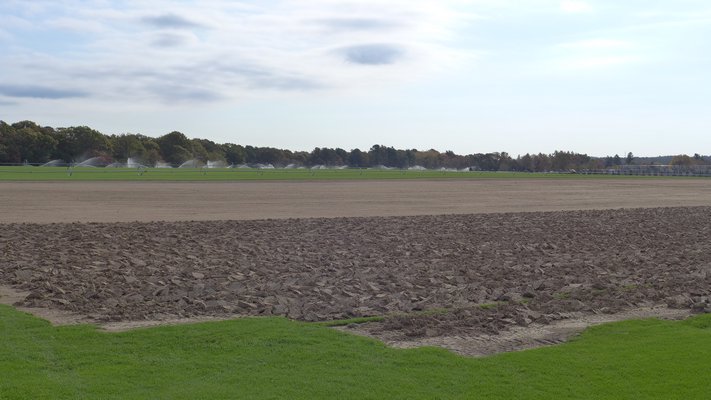

Yes, we’re in a drought.It’s not unusual for our area to have rather dry falls but they are usually punctuated by storms that are often tropical in origin and saturated with moisture. Not this year though.
As a result, there are some serious ramifications that you should consider, which may affect a number of areas in your landscape. You may also want to have a chat with your irrigation company or landscaper before they shut down your hose spigots and lawn irrigation, if it’s not too late.
Usually by this time of the year contractors are eager to blow out irrigation systems and drain outside water lines to finish up their year’s work. Gardeners tend to coil up their hoses, collect their sprinklers and get everything into the garage, shed or basement. But you may want to rethink that practice this year as some properties are already showing signs of a hasty retreat that might have been convenient but wasn’t necessarily timely.
If you’ve got an unirrigated lawn, you know what the issue is. The expanse of grass has turned brown, visibly warning that the soil is parched. Most lawn grasses in these areas have gone dormant a month or two early. Even for irrigated lawns, there is the threat of dormancy from the lack of rain.
Dormancy in and of itself doesn’t spell doom for a lawn, as many of our modern lawn grasses can go for as long as a month with no rain. Then, when the rains come, they bounce back. Yet as the ground gets cooler and the grass plants sense winter coming on, we may not see that recovery.
And what if the drought continues and we don’t get any good rains into November and little snow through the winter? Then the threat is desiccation of the grass plants during the winter. While that’s very rare in our area, it’s not out of the question, especially in our sandy soils.
So, what to do?
If you have the ability to irrigate, then keep your lawn well watered as long as there’s no threat of freezing your water lines. This shouldn’t be a problem in November, even if it goes down to the low 30s and upper 20s, as water under pressure is unlikely to freeze.
Keep in mind though that water evaporates from a lawn much more slowly in cooler weather. While you want to water, do it in moderation.
Water left in movable sprinklers, though, is another issue. So if you’re going to use them for the rest of the month, just be sure to drain them after use or if you see a very cold snap coming.
If you’ve got in-ground irrigation and it hasn’t been turned off yet, get in touch with your irrigation company and get their take on the situation. If your irrigation’s been running and isn’t shut down yet, your lawn is probably in good shape. Shutting down later in the month shouldn’t be an issue but don’t leave these systems on and workable past Thanksgiving.
If you’ve newly seeded your lawn, then it’s critical to keep it watered. Only with adequate fall soil moisture will the young grass plants thrive and survive the winter.
Newly sodded areas will need to be watered for at least two weeks or until the sod knits and can’t be pulled from the soil. Even after knitting, the sod should still be watered weekly through the month or until there’s a hard freeze.
There are also considerations beyond the lawn. If you’ve done any bulb planting you should water in those areas where the bulbs are.
You probably need to do this only once but water deeply so the soil becomes saturated down to the level of the bulbs. This can be 3- to 6-inches down, so after you water do a little excavation to see how deep the moisture is.
The object here is to get the moisture around and below the bulbs. This stimulates root growth. It’s these roots that feed the spring foliage and stems of the newly emerging plants. One good soaking this month should do it.
Fall or late summer perennials that have been planted this year should be watered at least through November or until we have a hard freeze if that’s possible. This will be especially critical for newly planted iris and peonies.
Here again, it’s the roots we want to encourage. A deep and vigorous root system that gets established in the fall not only promotes healthy growth in the spring but also helps to prevent any winter heaving caused by the soil freezing and thawing. If weakly rooted, this heaving can result in the weak plants being pushed right out of the soil where they will dry and the plant will probably die.
Newly planted trees and shrubs will also need water, but for most of us this can be done with a watering can or jug on smaller properties. Water them once a week and deeply. This is especially critical on evergreens, and that includes rhododendrons. For deciduous trees, it’s less critical but they still need moisture in the root zone to promote and encourage root growth. If you’ve bought containerized plants and haven’t gotten them into the ground yet, these too will need water both while potted and then when planted.
Watering trees and shrubs this fall shouldn’t be limited to just recently planted material. Anything planted from last spring onward should be watered through the month, especially in sandy soils or in windy locations.
So yes, water. But no, an emphatic no, don’t fertilize. Plants under stress should never be fertilized, and drought is certainly stressful.
Compost teas may be another issue. There is a school of thought that compost teas and some other biostimulants can help plants during droughts. But, everything in moderation.
Keep growing.
 More Posts from Andrew Messinger
More Posts from Andrew Messinger